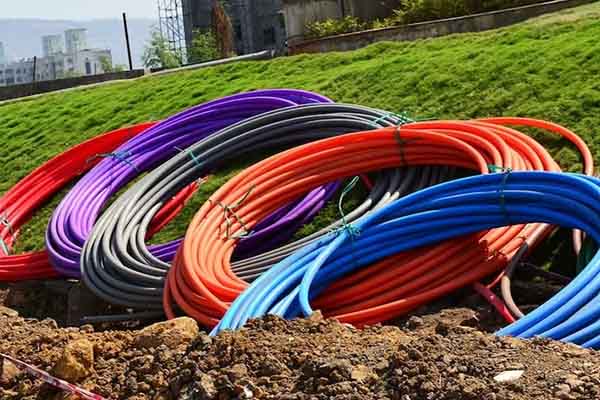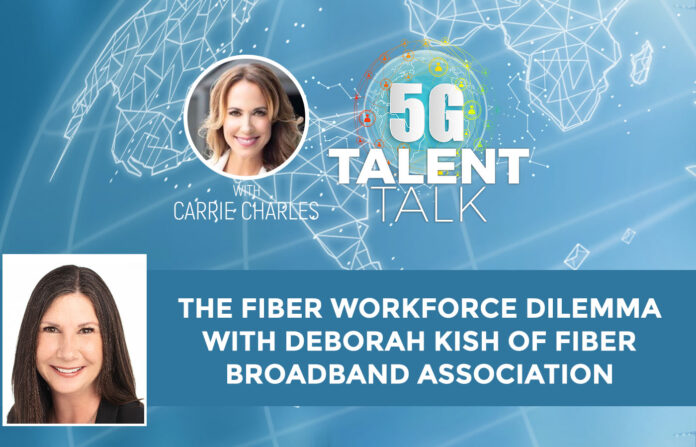How do we get the younger generation of workers interested in the telecommunications industry? As the skilled labor shortage continues to grow, the solution is certainly not ‘easy.’ Thankfully, the Fiber Broadband Association provides resources that make this industry-wide effort a whole lot simpler.
Joining us today is Deborah Kish, VP of Research and Workforce Development for the Fiber Broadband Association. In this insightful interview, Carrie and Deborah dive into FBA’s top strategies, programs and playbooks to combat the telecom workforce shortage and prepare for the BEAD funding wave ahead.
Tune in now to stay up-to-date on the future of our industry, and catch a sneak peek at the insights to be uncovered at Fiber Connect 2023. Don’t miss this opportunity to give your fiber company the head start in preparing for our new world of work.
—
Watch the episode here
Listen to the podcast here
The Fiber Workforce Dilemma with Deborah Kish of Fiber Broadband Association
In this episode, I have with me Deborah Kish. She is the Vice President of Research and Workforce Development at the Fiber Broadband Association. Deborah, thanks for joining me.
Thanks, Carrie. It’s good to be here.
I was so excited when we had that panel at Connect X in 2023. I thought, “I got to get you on the show,” so I’m excited about this conversation.
Me too, and here we are.
I always like to learn a little bit more about you and how you got to where you are.
I have been in the telecommunications business or industry for many years. I added up the numbers a little bit ago and tried to figure out how long I’ve been doing this. I started my career at Gartner as an analyst. I was covering telco infrastructure. I started covering broadband, oddly enough, and then I moved on to other topics like switching and signaling. I moved into security and then dabbled in data security more in-depth. I left for another opportunity after 21 years. I am here at Fiber Broadband Association so I feel like I’ve come full circle on the broadband side. It’s a great industry to be in. Once you’re in, you don’t ever want to get out.
Tell me more about your role at FBA.
I run research and workforce development initiatives here. On the research side, I manage research programs and the relationships that we have with folks like RBA, Futurian, and Cartesian where we also create committee-driven research. There’s organic research that is driven at Fiber Broadband Association and other research that we rely on partners for.
On the workforce development side, FBA had in response to our service provider and contractor members and a recognition in the industry as a whole that there’s a gap in training. It is not so much that there isn’t training available. There is fiber optic technician training available but we created a program or a training course to help standardize training across the board. Fiber is a young-ish industry that is 35 or 40-ish years old.
We’re in a unique position where we have not done a very good job of attracting new people to the industry to become fiber optic technicians or even get into the telecommunication space. A lot of the people who would be instructors are still working. We’re in a unique gap where we don’t have a pipeline that is full of people to take these positions but also, we don’t have instructors to help instruct them. What’s generally been happening is there’s been a lot of on-the-job training with contractors and service providers to get people to become fiber optic technicians and other occupations within the industry.

Who is the Fiber Broadband Association? Talk more about your members and maybe some of the benefits of being a member.
We are a member-led and member-based organization. Our members are largely internet service providers and that goes into even municipalities. We see a lot of electric cooperatives getting into the fiber space, offering fiber broadband service to their communities. We’re close to 450 members, which is nice. We’ve grown quite a bit in the last few years. The other portion of our members is largely the manufacturers of fiber optic cable, tools, and contractors, the people who are out there deploying the technology.
We’ve also got another subset of consultants and other software-type vendors like GIS where they would look at how to find fiber or where fiber is deployed across the nation. The benefits of becoming a member here are long and vast. A big part of it is ultimately the connections that our members make with each other. Not to mention we are what we would consider the voice of fiber or the truth of fiber in terms of advocating for all fiber broadband networks across the country.
The Fiber Broadband Association is the voice of fiber in terms of advocating for all fiber broadband networks across the country.
You have quite a few events every year. I know you have a big one coming up, Fiber Connect, which I’m going to attend in Orlando. What’s the date of that?
August 20th to the 23rd, 2023. That’s great that you’re going to be there.
My whole team will. I heard there’s going to be record attendance in 2023. Was it over 2,000?
We’re expecting about 4,000. We’ve been growing every year.
That is a great show. Every year, I go. There are lots of benefits. I get emails all the time from your organization and learn a lot. Let’s dig into the workforce a bit. Typically, telecom is not the first choice of young people. Right out of high school or college, they don’t think, “I’m going to go into telecom” How do we get more people, and not just young people but all ages, interested in telecom?
That is the $10 million question. I don’t remember sitting in high school thinking to myself, “I want to get into the telecom industry.” We all fell into it, which is a good thing. The people who fall into it tend to enjoy it and never want to leave. We have good retention of employees but what happened along the way was that because technology moves at such a lightning speed, the changes that we’ve seen across the board, things like writing code or developing apps because the catchphrase was always, “There’s an app for everything,” attracted a lot of young people to a different path. I don’t think that they thought that how you get there is by means of the internet.
When you ask how to attract people to the industry, we need to make it known or relatable. When you create those apps, you are marketing your product, you want to be an entrepreneur, or you want to connect to your school or your family through things like Facebook and Instagram and want to send your message out, all of that goes across the internet to make it relatable in how they understand how their communications happen.
There’s always the wireless. Everybody knows wireless. Young people don’t think to themselves. They think it’s a cell phone. They are like, “I know I can connect to the internet using it,” but they don’t see the people behind the actual work that goes into it. When we’re talking about fiber, I think of the magic that happens with it. It’s fascinating how the stuff happens through light. How do you send data through light? There are physical components to it but you don’t think about the science behind light and how it transmits data at speeds that we still haven’t broken it.
The FBA did a survey. Let’s talk a little bit about that and what was included in the survey. I find that very interesting.
Every year, the Fiber Broadband Association does that along with the main coalition, which is the Fibre to the Home Council Global Alliance, which we are part of. We’re the Americas branch. We’re Latin America and North America. What we do every year is conduct a large project and get all the continents together. In 2023, we did a sustainability survey. A sustainability survey is the obvious things like greenhouse gas emissions and what you are doing to reduce carbon output, your carbon footprint, and all the things that go together with that.
One of the things that fall under the sustainability category is employee advancement. Since I’m a workforce and that’s one of my main interests, I like to look at the workers’ category. We ask some questions around, “What initiatives are you as a company conducting or working on towards employee advancement?” Those mean the broad categories like financial security, health, wellness, and safety, career development, and engagement and satisfaction.

Engagement and satisfaction are all things about, “How happy are you working here?” It’s always good to find out what your employees think of working for you as a company and how to keep them there. There are other things about engagement and satisfaction in terms of collective bargaining and how caregivers are engaged in your everyday life in terms of making sure that you and your family are well taken care of and that your work-life balance is well met. A lot of companies don’t necessarily do that. Results of that portion, I was quite surprised at.
On the sustainability side as a whole, we discovered that North America is a little bit behind but they’re working on things like changing to fiber from copper to reduce carbon emissions in their carbon footprint. On the worker side, I was surprised to see across the board how that was the lowest on the list in terms of initiatives. The best way to get stewards of your company is to be invested in them. We found that people will leave, fiber optic technicians for example in that one category, for $1 an hour. We know that there’s a lot of poaching that happens in this industry but that’s one small example of why people leave.
Where can we get access to the survey?
On the Fiber Broadband Association website.
What is that? Let’s go ahead and give it.
It is www.FiberBroadband.org.
What initiatives are you working on to attract more people to the industry?
The ideas are endless. We are doing a bunch of different things. One big thing that we’re going to announce at Fiber Connect, which I don’t want to say too much about, is we’re going to be releasing something out to the wild to attract young high schoolers and pretty much anybody who’s interested in the telecom business.

Another thing that we’re working on is developing a marketing toolkit for community colleges and high schools that can be inserted into things that young people do every day, which is across Facebook, Instagram, and TikTok. It is all the things that young people are doing on a day-to-day basis to insert advertisements or videos of people who have been in this industry for a long time, what the benefits are, the career opportunities, the earning potential, and all those things that are so awesome about this industry. We develop that toolkit. We, as the Fiber Broadband Association, will also put out to the nines about all the things that this industry has to offer.
I’m a member company in the fiber world or any company in telecom. I’m looking to hire a young person, maybe a Millennial or a Gen Z. Would I need to have a presence on Instagram and TikTok? Facebook is for old folks like me. Is it important and effective to find candidates on these social media platforms?
It can never hurt. I don’t think our industry is something that is typical on TikTok or Instagram. Sure, why not? It couldn’t hurt. TikTok tends to be the videos that people do that try and attract attention to themselves and things like that. I’m also thinking about things like gaming apps. The young people play Candy Crush. Everybody knows what Candy Crush is. There are a lot of ads that get inserted into those games to either get boosters or whatever it is. I don’t do those kinds of things but I know that this is what happens. They insert ads because adults do it too.
Other places that we were thinking about are other apps like Nextdoor. If you have heard of it, it is the one where it’s all about neighborhoods and people who want to connect in a neighborhood to either say, “My cat’s missing. My mail got delivered to the wrong place. Who has it,” and things of that nature. That’s also very ad-driven too. We can put ads into those kinds of apps as well where we’re not just reaching young people but we’re reaching their parents.
They are parents of kids who don’t know where they want to go. I see it all the time. I belong to the Nextdoor app. I see it all the time when people are looking for jobs for their kids. They’ll put an ad out there that says, “My kid needs a job over the summer. He wants to cut grass,” or something. This is a high schooler. These are other ways to get the visual content out there that maybe a parent would see and say, “Have you thought about a career in Fiber or telecommunications? Let’s face it, Jimmy. You’re not quite sure what you want to do.”
I love all those ideas. We’ve got to get with the times here sometimes as companies. We have an Instagram page as well as I believe we have a TikTok page. Let’s talk about the workforce shortage. You’ve heard about this throughout telecom for many years and the gaps that we’re seeing. Do you feel that with the economic conditions and everything happening in the marketplace, is this shortage still going to be a major problem for us? What type of shortage or gap do we see coming, especially with the BEAD funding and all the building that needs to be done?
The shortage is going to be an issue for a while. It is largely because I don’t see anybody acting on it. This is the time. With BEAD funding, the allocations have been announced to all the states. The states know how much money they’re going to be getting from BEAD funding, which is a great thing. I don’t think that they’re going to be physically getting the money until early 2024, which indicates this is the clear time to do something in terms of training and hiring.
The skilled labor shortage is going to be an issue for a while and it’s largely because nobody is acting on it.
Whether you go with an apprenticeship model or not, I don’t think that that matters. Apprenticeships are great. I love the earn-while-you-learn model. We need to have training because when that money starts rolling out, then they’re going to want to start building networks. You can’t build a network unless you build a workforce.
Operators or ISPs and contractors need to start thinking about getting people trained rather than waiting until the money comes through. You’ll always be able to make up that difference when you start getting new subscribers. As you grow your subscribers, you are still going to need people to maintain existing networks. It is not only to build new networks but maintain the existing networks. That’s going to be an ongoing thing so you have to build that pipeline.
We expect new hires. We estimated that 205,000 people will be needed over the next few years. We’ve seen some evidence around the states and what they’ve indicated as the number of people that they’ll need. They’re not all necessarily going to be in fiber per se because fiber deployment takes several different categories of occupations. For example, Louisiana had a number of about 7,000 people that they anticipate they’ll need over the next seven years. North Carolina indicated a number of about 4,500. The number is going to be different across each state but when we add up on the average, the 205,000 to probably 250,000 or so over the next few years is not unreasonable. We can get there if we start acting.
Where do we find these people? Is it all about training and development programs? If so, where are the training and development programs? Are they internal with companies? Are the states going to implement them? How are we going to do this?
It’s going to be a combination of things. At a state level, we have to look at all the stakeholders. There are all kinds of coalitions and workforce development programs that are all working together. Some of the states have training programs. They’re not necessarily training programs but they’re programs that would be offered to people within the state. They could offer XYZ training, for example, fiber optic technician training, at a lower cost to them and bring in those people to the industry.
Other programs are at-risk youth programs. There are veteran programs. Another way that would be of interest is to bring vocational tech training back to high schools. Give them familiarity and a taste of what these jobs would entail. When they come out, they can go into more formal training programs and get jobs immediately.

What would you say that a company would need to do to start that preparation? Do you have a partnership with TIRAP and WIA as well? Can you talk a little bit about that?
The WIA or Wireless Infrastructure Association is the sponsor of TIRAP, the Telecommunications Industry Registered Apprenticeship Program. Within the TIRAP apprenticeship program, there are fifteen working on more occupations that are built into that registered apprenticeship program. Fiber optic installer is one of them. They’re all Telco related. They run anywhere from tower buildings to underground cable installation to fiber broadband technicians. We partner with the WIA to be that fiber optic technician arm that is available.
I like the apprenticeship model. The earn-while-you-learn is a great program. It helps foster a good relationship between a new employee and somebody who is learning the trend of the technology install practices. It shows that there’s an interest in that person’s career and earning potential. Dedication and commitment from employers are very much on the list of what needs to be done too. We need commitments from people in the industry, from ISPs and contractors alike. TIRAP is a good way to start that.
To get more information on that program with companies, do they go to your website, the Fiber Broadband Association website?
They could either go to our website or contact me directly at DKish@FiberBroadband.org. I’d be able to get them in touch with the WIA folks.
Let’s give that website one more time, the Fiber Broadband Association website.
It is www.FiberBroadband.org.
Are there still spots to register for Fiber Connect?
Yeah, there is. We have sold out the Gaylord Hotels but on the Fiber Connect website, there is information about adjacency hotels that we have arrangements with. By no means have we sold out of the conference so there is still plenty of room for people to join. We welcome them. It’s going to be a great show in 2023.
I cannot wait, Deborah. Thank you for all the work that you’re doing. We need it. I ] appreciate you coming to the show.
Thanks so much for the opportunity, Carrie. This has been great. It’s always awesome working with you.
You too. I’ll see you soon at the event.
Thanks. I’ll see you soon.
Take care.
Important Links
- Fiber Broadband Association
- Nextdoor
- DKish@FiberBroadband.org
- https://www.LinkedIn.com/in/DeborahKish
- FBA@Connect2Comm.com
About Deborah Kish
 Deborah Kish is the VP of Research & Workforce Development for the Fiber Broadband Association. In her role, Deborah Kish is leading FBA’s research initiatives as well as serving as team lead building “OpTIC™” (Optical Telecom Installer Certification), the association’s fiber optic technician certification program. She also serves on the WIA Advisory Committee. Prior to the FBA, she spent over 20 years as an analyst at Gartner, covering broadband, telecom switching, signaling and security topics advising thousands of service provider and vendor clients about product and service strategy.
Deborah Kish is the VP of Research & Workforce Development for the Fiber Broadband Association. In her role, Deborah Kish is leading FBA’s research initiatives as well as serving as team lead building “OpTIC™” (Optical Telecom Installer Certification), the association’s fiber optic technician certification program. She also serves on the WIA Advisory Committee. Prior to the FBA, she spent over 20 years as an analyst at Gartner, covering broadband, telecom switching, signaling and security topics advising thousands of service provider and vendor clients about product and service strategy.
Love the show? Subscribe, rate, review, and share!
Join the 5G Talent Talk Community today:

